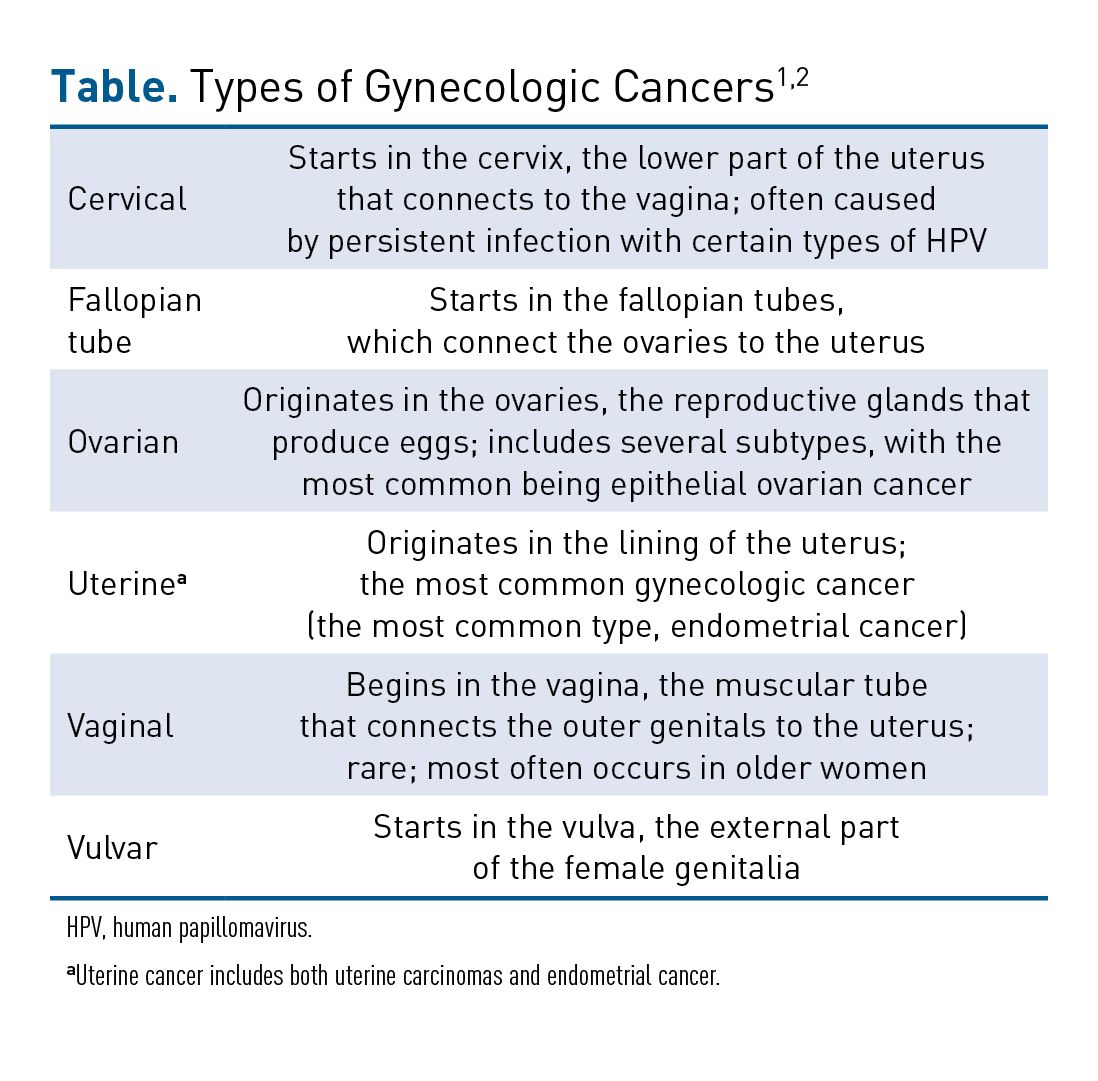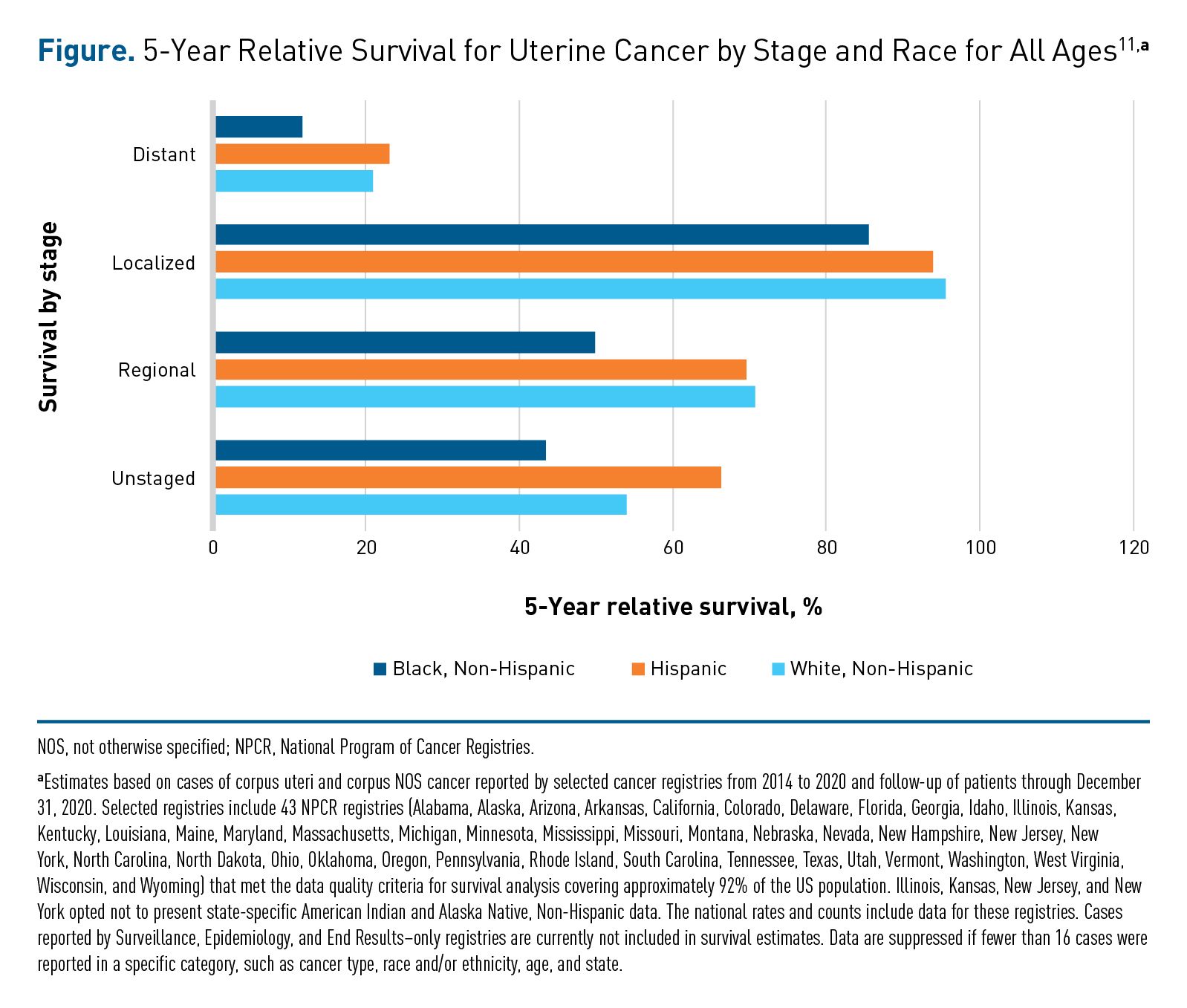- Center on Health Equity & Access
- Clinical
- Health Care Cost
- Health Care Delivery
- Insurance
- Policy
- Technology
- Value-Based Care
Addressing Racial and Socioeconomic Inequities in Gynecologic Cancer Care: Challenges and Opportunities for Improvement
Gynecologic cancers involve the uncontrolled growth and spread of abnormal cells that originate in female reproductive organs including the cervix, ovaries, uterus, fallopian tubes, vagina, and vulva (Table).1,2 Over 108,000 women in the United States will be diagnosed with a gynecologic cancer in 2024. Each type of gynecologic cancer presents unique signs, symptoms, and risk factors. Genetic factors can substantially increase the risk of developing certain gynecologic cancers; for example, mutations in the BRCA1 and BRCA2 genes are associated with an increased likelihood of developing ovarian and breast cancers.3,4

Symptoms of cervical, uterine, ovarian, and vaginal cancers can include abnormal vaginal bleeding or discharge; of ovarian cancer may include bloating, feeling full quickly, and abdominal or back pain; of ovarian and uterine cancers may include pelvic pain; of ovarian and vaginal cancers may include urinary changes; and of vulvar cancer may include itching, burning, pain, or skin changes like rashes or sores.5 Treatment for gynecologic cancers include surgery, chemotherapy, and radiation.6 First-line treatment options vary depending on the specific type of cancer and its stage at diagnosis.
Uterine cancer, which includes endometrial cancer and uterine sarcomas, is the most common gynecologic cancer and the ninth most common cancer diagnosed in the US, with an estimated 67,880 new diagnoses expected in 2024.7 Mortality from ovarian cancer was historically higher than that from uterine cancer in the early 1990s, but it has been decreasing; on the other hand, the incidence and mortality rates of uterine cancer have been rising with mortality rates increasing 1.7% each year since 2013.7,8 Mortality associated with uterine cancer among Black women is particularly high; mortality rates for this population are now twice as high as those for White women (9.5/100,000 vs 4.7./100,000 women) even though the incidence rates for the malignancy are similar.7
Uterine cancer is most frequently diagnosed among women aged 55 to 64 years, with the median age at diagnosis being 64 years. The prognosis for endometrial cancer varies depending on the stage at diagnosis. Five-year relative survival rates for regional and distant uterine cancer are approximately 70% and 19%, respectively. The 5-year relative survival rate for early-stage or localized uterine cancer is about 95%.7
Early diagnosis and treatment are critical for improving outcomes of patients with gynecologic cancers. However, the absence of screening tests remains a challenge—diagnosis primarily is based upon symptom onset, and often correlates with more advanced disease severity.9,10 Considerable gaps in care, particularly among members of racial and ethnic minority groups, contribute to disparities in diagnosis, treatment, and survival.
CURRENT GAPS IN CARE
The 5-year relative survival rates for Black women with regional and distant uterine cancer are 49.8% and 11.7%, respectively, compared with 70.7% and 20.9% for White women (Figure).11 Further, compared with White women, patients from other racial and ethnic groups have a lower proportion of early-stage cervical cancer diagnoses. For example, the results of a study of 23,942 women aged 21 to 64 years who were diagnosed with early-stage cervical cancer showed that 48.7% were American Indian or Alaska Native, 49.9% were Asian or Pacific Islander, 41.7% were Black, and 51.6% were Hispanic or Latina as compared with 53.3% who were White.12 Women with private or Medicare insurance were more likely to be diagnosed at an early stage than were those who had Medicaid coverage or who were uninsured (57.8% vs 41.1%, respectively). After adjusting for various factors, Black women had higher odds of receiving advanced-stage cervical cancer diagnoses than did White women (odds ratio, 1.18; 95% CI, 1.08-1.29). Health insurance mitigated more than half of the racial disparities in advanced-stage diagnoses across all minority groups.12 Limited health care accessibility and affordability contributes to delays in diagnosis, which is a key concern related to the observed disparities in gynecologic malignancies.13

Disparities in Patient Care
Racial, ethnic, and economic disparities across the incidence, treatment, and mortality among patients with uterine cancer are well documented.14 Black patients are less likely than are White patients to receive appropriate diagnostic workups after experiencing postmenopausal bleeding, and this delay may contribute to delayed diagnoses.15 Additionally, minority and low-income women often are less likely to undergo regular screenings for cervical, breast, colorectal, and lung malignancies, among others, because of various aspects of social determinants of health.16 Further, individuals with low incomes, limited health literacy, long travel distances to access care, no or insufficient insurance, lack of transportation, or unpaid medical leave are less likely to seek out recommended cancer screenings. Black women also are less likely than are White women to receive guideline-concordant care, even when receiving treatment at an academic medical center.17 Among many factors, differences in adherence to evidence-based treatment guidelines between Black and White women with endometrial cancer have been associated with variations in survival rates.
The underrepresentation of women belonging to racial and ethnic minority groups in clinical trials also poses a considerable challenge to the delivery of equitable and effective health care. Clinical trials play a crucial role in the study of disease pathophysiology and treatment modalities. The representation of patients belonging to racial and ethnic minority groups in these trials is essential for studying genetic variances and socioeconomic factors to better understand their impact on patient outcomes and potentially identify more suitable treatment options. However, women belonging to minority groups are significantly underrepresented in clinical trials, particularly in the United States. For instance, in clinical trials leading to FDA approval of new drugs in 2018, only 4% of participants were Black even though Black individuals make up 13.4% of the US population. This disparity is also evident in gynecologic oncology, which further impacts disparities in patient care. However, the results of clinical trials that randomly assigned women with ovarian cancer to treatment groups irrespective of race demonstrated that disparities in outcomes between Black and White women disappeared, suggesting that unequal access to care is a significant driver of differences in cancer trajectory.18
ECONOMIC CONSEQUENCES OF DISPARITIES IN GYNECOLOGIC CANCER CARE
Financial toxicity refers to the financial strain and burden that patients experience due to the costs associated with their cancer treatment. For patients with gynecologic cancers, financial toxicity can be considerable. Often, patients with gynecologic cancers face high medical expenses related to insurance, health services, and travel to care. This financial burden can be exacerbated by indirect costs related to lost income, cost of transportation, and caregiving needs. More than half of patients with gynecologic cancer experience financial distress when they begin a new treatment, and this is linked to material hardship.19
Patients with gynecologic cancers face increased odds of financial toxicity if they are younger than 65 years, belong to Black or Hispanic ethnic groups, have lower income or education levels, or are uninsured or unemployed. Financial assistance programs exist, but they often are limited, especially for Medicare patients. Although the Inflation Reduction Act of 2022 was intended to alleviate some of these financial burdens by capping annual out-of-pocket costs at $2000 and introducing measures to control drug prices, patients still experience challenges.19
THE IMPORTANCE OF PATIENT AND PROVIDER EDUCATION
Patient education is crucial in the early detection and treatment of gynecologic cancers. Knowing the symptoms of cervical, ovarian, uterine, vaginal, and vulvar cancers can lead to early detection and timely, appropriate medical care.20 The CDC’s Division of Cancer Prevention and Control provides targeted research, programs, and partnerships that focus on cancer prevention and treatment, particularly for underserved populations.21 The CDC’s Inside Knowledge campaign plays a vital role in this effort by raising awareness and providing critical information about gynecologic cancers.20 Inside Knowledge supports the Gynecologic Cancer Education and Awareness Act of 2005, also known as Johanna’s Law. Key initiatives include raising awareness about cancer risks among populations having a high incidence of malignancy, improving access to cancer screening for medically underserved and low-income individuals, and studying the cost of and barriers to preventive care and treatment.21
The Gynecologic Cancer Education and Awareness Act of 2005 aimed to increase awareness and knowledge of gynecologic cancers among health care providers and patients. It includes activities such as maintaining a supply of written educational materials for women and making public service announcements. These announcements are designed to encourage discussion about cancer risks among women and their health care providers and to highlight early warning signs and risk factors based on the latest medical information.22
In addressing disparities in gynecologic cancer care, and particularly for endometrial cancer, targeted interventions are essential to improve outcomes among underserved populations. Reducing gaps in early diagnosis, increasing access to evidence-based treatments, and providing financial support can lessen the disproportionate burden on members of racial and ethnic minority groups and women who are experiencing economic disadvantages.
REFERENCES
1. Gynecologic cancers basics. CDC. Updated September 12, 2024. Accessed October 31, 2024. https://www.cdc.gov/gynecologic-cancer/about/index.html
2. Basic information about HPV and cancer. CDC. September 17, 2024. Accessed October 31, 2024. https://www.cdc.gov/cancer/hpv/basic-information.html
3. Family history & cancer. CDC. September 2018. Accessed October 31, 2024. https://www.cdc.gov/cancer/gynecologic/pdf/family-history-factsheet-508.pdf
4. Welcsh PL, King MC. BRCA1 and BRCA2 and the genetics of breast and ovarian cancer. Hum Mol Genet. 2001;10(7):705-713. doi:10.1093/hmg/10.7.705
5. Symptoms of gynecologic cancers. CDC. Updated September 5, 2024. Accessed October 31, 2024. https://www.cdc.gov/gynecologic-cancer/symptoms/index.html
6. Treatment of gynecologic cancers. CDC. Updated September 5, 2025. Accessed October 31, 2024. https://www.cdc.gov/gynecologic-cancer/treatment/index.html
7. Cancer stat facts: uterine cancer. Surveillance, Epidemiology, and End Results Program. Accessed October 31, 2024. https://seer.cancer.gov/statfacts/html/corp.html
8. Giaquinto AN, Broaddus RR, Jemal A, Siegel RL. The changing landscape of gynecologic cancer mortality in the United States. Obstet Gynecol. 2022;139(3):440-442. doi:10.1097/AOG.0000000000004676
9. Screening for uterine cancer. CDC. Updated September 9, 2024. Accessed October 31, 2024. https://www.cdc.gov/uterine-cancer/screening/index.html
10. Dolly D, Mihai A, Rimel BJ, et al. A delay from diagnosis to treatment is associated with a decreased overall survival for patients with endometrial cancer. Front Oncol. 2016;6:31. doi:10.3389/fonc.2016.00031
11. US Cancer Statistics Working Group. US Cancer Statistics Data Visualizations Tool. US Department of Health and Human Services, CDC and National Cancer Institute. Data released June 2024. Accessed November 5, 2024. https://gis.cdc.gov/Cancer/USCS/#/SurvivalbyStage/
12. Holt HK, Peterson CE, MacLaughlan David S, et al. Mediation of racial and ethnic inequities in the diagnosis of advanced-stage cervical cancer by insurance status. JAMA Netw Open. 2023;6(3):e232985. doi:10.1001/jamanetworkopen.2023.2985
13. Najor A, Melson V, Lyu J, et al. Disparities in timeliness of endometrial cancer care: a scoping review. Obstet Gynecol. 2023;142(4):967-977. doi:10.1097/AOG.0000000000005338
14. Whetstone S, Burke W, Sheth SS, et al. Health disparities in uterine cancer: report from the uterine cancer evidence review conference. Obstet Gynecol. 2022;139(4):645-659. doi:10.1097/AOG.0000000000004710
15. Doll KM, Khor S, Odem-Davis K, et al. Role of bleeding recognition and evaluation in Black-White disparities in endometrial cancer. Am J Obstet Gynecol. 2018;219(6):593.e1-593.e14.doi:10.1016/j.ajog.2018.09.040
16. Cancer disparities. National Cancer Institute. Updated March 21, 2024. Accessed October 31, 2024. https://www.cancer.gov/about-cancer/understanding/disparities
17. Huang AB, Huang Y, Hur C, et al. Impact of quality of care on racial disparities in survival for endometrial cancer. Am J Obstet Gynecol. 2020;223(3):396.e1-396.e13. doi:10.1016/j.ajog.2020.02.021
18. Towner M, Kim JJ, Simon MA, Matei D, Roque D. Disparities in gynecologic cancer incidence, treatment, and survival: a narrative review of outcomes among black and white women in the United States. Int J Gynecol Cancer. 2022;32(7):931-938. doi:10.1136/ijgc-2022-003476
19. Liang MI, Harrison R, Aviki EM, Esselen KM, Nitecki R, Meyer L. Financial toxicity: a practical review for gynecologic oncology teams to understand and address patient-level financial burdens. Gynecol Oncol. 2023;170:317-327. doi:10.1016/j.ygyno.2023.01.035
20. About the Inside Knowledge campaign. CDC. Updated September 5, 2024. Accessed October 31, 2024. https://www.cdc.gov/gynecologic-cancer/inside-knowledge/index.html
21. What CDC Is doing to achieve equity in cancer control. CDC. January 12, 2024. Accessed October 31, 2024. https://www.cdc.gov/cancer/health-equity/what-cdc-is-doing.html
22. Johanna’s Law, HR 1245, 109th Cong (2006). Accessed August 29, 2024. https://www.congress.gov/bill/109th-congress/house-bill/1245
